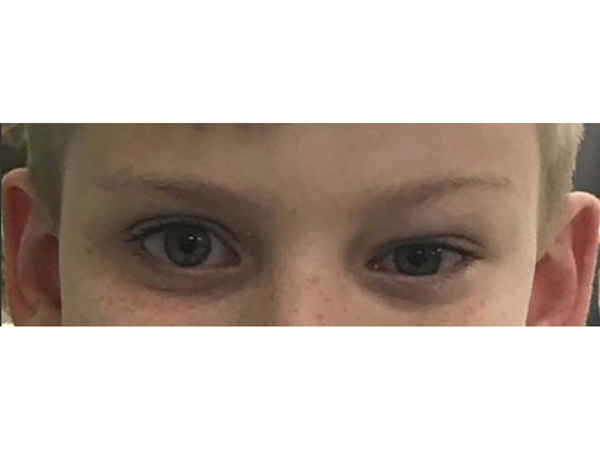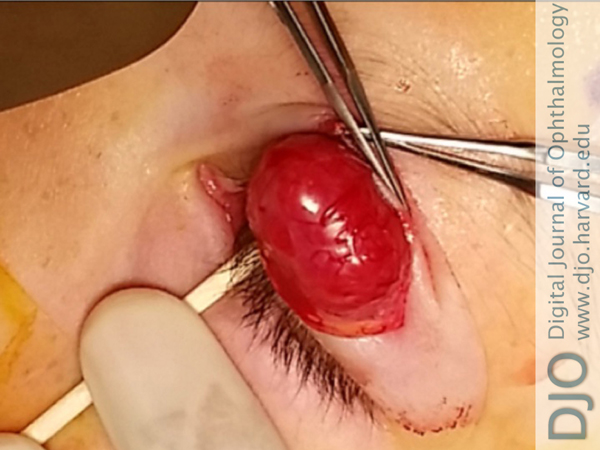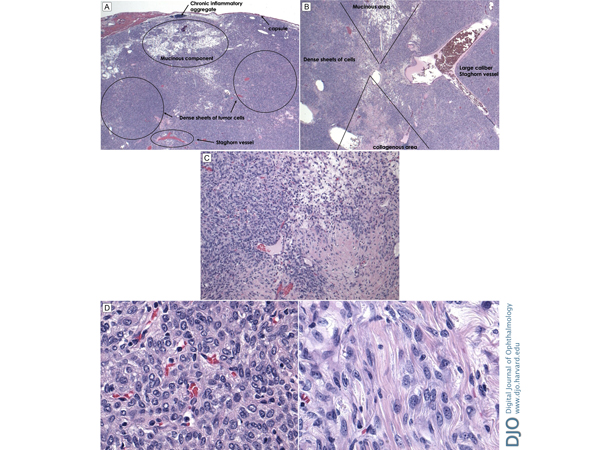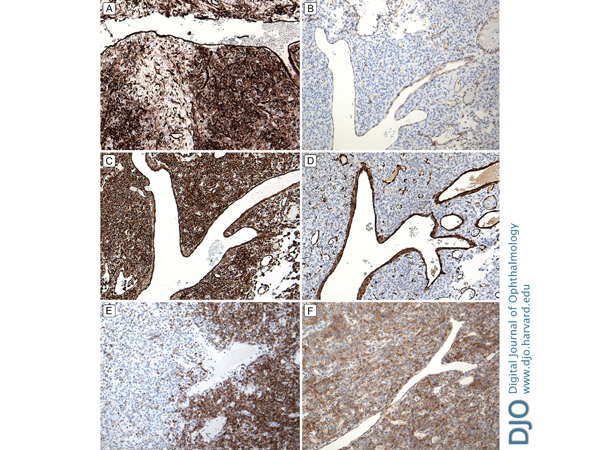An 8-year-old with a unilateral droopy eyelid
Digital Journal of Ophthalmology 2022
Volume 28, Number 1
February 4, 2022
Volume 28, Number 1
February 4, 2022
Download PDF

Figure 1.
Left upper eyelid ptosis is appreciated along with a slight elevation of the eyelid nasally.
Left upper eyelid ptosis is appreciated along with a slight elevation of the eyelid nasally.

Figure 2.
B-scan ultrasound showing no calcifications nor fluid anterior to the levator palpebrae superioris muscle. The lesion demonstrates low internal reflectivity and moderate sound attenuation.
B-scan ultrasound showing no calcifications nor fluid anterior to the levator palpebrae superioris muscle. The lesion demonstrates low internal reflectivity and moderate sound attenuation.
The patient returned 15 days later for a postoperative evaluation. His visual acuity was 20/20 in each eye, and his left eye external examination showed normal eyelid structure and position, with a healing scar in the left upper lid. Subsequent magnetic resonance imaging (MRI) showed unremarkable orbits without evidence of residual mass or abnormal enhancement.

Figure 3.
Intraoperative image of an orbitotomy with removal of lesion (left upper eyelid).
Intraoperative image of an orbitotomy with removal of lesion (left upper eyelid).

Figure 4.
A, Gross specimen of tan-colored tumor showing globular morphology with capsule. B, Gross specimen of capsule showing outer layer and inner layer of cellular tissue; small vessels are present throughout.
A, Gross specimen of tan-colored tumor showing globular morphology with capsule. B, Gross specimen of capsule showing outer layer and inner layer of cellular tissue; small vessels are present throughout.
SFTs most often occur in the pleura, mediastinum, or lung, but extrapleural sites include the orbit. The tumor does not show any sex predilection;(1-4) SFTs usually present in older age groups, but a small number have been reported in pediatric patients. Tumor size can range from 0.4 to 10 cm, with a mean of 1.3–2.6 cm. They are round to ovoid, mobile, nontender, and are occasionally the cause of mechanical ptosis or diplopia.(4-6) Most SFTs follow a benign course; however, rare exceptions have been reported to be more aggressive, transforming into a malignant tumor with metastasis.(5,7)
On ultrasound, SFTs are firm and noncompressible, display low-to-medium internal reflectivity (tumors with densely packed cells typically are low reflective), and regular internal structure (SFTs typically have a homogeneous architecture, moderate sound attenuation, and possibly some degree of vascularity).(8,9) Computed tomography (CT) or MRI will reveal encapsulated, ovoid masses typically located in extraconal tissue and without bony erosion.(5,8) CT scan may reveal a moderately enhancing, high-density mass. T1-weighted MRI demonstrates hypointense to isointense signal with respect to gray matter, and depending on the density of the tumor, T2-weighted MRI may either reveal a hypointense or hyperintense clearly demarcated mass.(7,8)
Complete surgical resection with clear margins is necessary, because recurrence and malignant transformation, although rare, is possible.(5,7-12) Excision alone may suffice, but excision with chemotherapy and radiotherapy may be warranted.(12) Most patients with residual disease left after resection fare well; however, a case of malignant transformation leading to high-grade sarcoma 9 years after initial resection and relapse treated with methotrexate, corticosteroids, antibiotics, and radiotherapy has been reported.(11) It was observed that residual infiltrative margins may serve as a predisposing factor for relapse, and radiotherapy should be considered with caution. Thus, long-term follow-up is necessary for patients diagnosed with SFT.(3,7,11,12)
SFT typically affects adults, with a median age range of 24-72 years; however, orbital SFT has been reported in a 5-year-old patient, underscoring the fact that SFT in children should not be overlooked, because a missed diagnosis could prove devastating.(11)
SFTs often grow in a “patternless” fashion, with alternating areas of hypo- and hypercellularity, often with staghorn-type vasculature. They show strong positive immunoreactivity to CD34, CD99, bcl-2, and vimentin but negative reaction to S-100 protein and smooth muscle actin.(1-4,8) CD34, which is most consistently positive in SFTs, is a glycoprotein found on the surface of hematopoietic progenitor cells, blood vessel endothelium, the dendritic interstitial cells of mesenchyme, and certain connective tissue cells in the skin.(9,10)
SFT and hemangiopericytoma are considered the same entity, however, the former term is now preferred. SFT is translocation defined by the presence of the NAB2-STAT6 gene fusion, as detected with fluorescence in situ hybridization, next generation sequencing, or with a STAT6 immunohistochemical stain. Although our patient’s pathology is certainly consistent with solitary fibrous tumor, it would have been helpful to have one of these, because CD34, BCL2, and CD99 are found in but not specific for this tumor. Solitary fibrous tumors demonstrate CD34, Bcl-2, p53, and Ki-67 positivity, collagen-rich stroma, fibroblast-like cells, and giant cells.(6) Fibrous histiocytomas demonstrate different pathogenesis and immunostaining patterns, such as STAT6 and CD34 negativity. As stated previously, malignant transformation is rare; however, if present would appear as mitotic figures greater than 4 per 10 high-power fields with cellular pleomorphism, hypercellularity, nuclear atypia, high MIB-1 labelling, and focal areas of necrosis.(4,6,8,11)
Although exceptionally rare in the pediatric population, orbital solitary fibrous tumors should be considered in the differential diagnosis in patients presenting with painless orbital masses causing mechanical ptosis. SFTs can be visualized on ultrasonography, MRI, and CT imaging. Management includes complete resection with clear margins and proper identification requires immunohistochemical evaluation. Most cases of orbital SFTs are benign and with proper treatment patients typically have a very good prognosis.
Acknowledgments
The authors thank Dr. Robert Rosa Jr. for performing gross specimen sectioning and immunohistochemical staining for the pathology slides.

Figure 5.
A, Overlying capsule surrounding areas of chronic inflammatory aggregate, mucinous components, dense sheets of collagen producing tumor cells, and stag horn vessels in a “patternless” arrangement. B, Histologic slide displaying collagenous area, large-caliber stag horn vessel, dense sheet of tumor cells, and mucinous area. C, Higher-power image displaying dense sheet of tumor cells, mucinous area, and collagenous area. D, Dense sheet of spindle-shaped cells with numerous vascular slits (left) and tumor cells producing collagen fibrils (right).
A, Overlying capsule surrounding areas of chronic inflammatory aggregate, mucinous components, dense sheets of collagen producing tumor cells, and stag horn vessels in a “patternless” arrangement. B, Histologic slide displaying collagenous area, large-caliber stag horn vessel, dense sheet of tumor cells, and mucinous area. C, Higher-power image displaying dense sheet of tumor cells, mucinous area, and collagenous area. D, Dense sheet of spindle-shaped cells with numerous vascular slits (left) and tumor cells producing collagen fibrils (right).

Figure 6.
Tumor cells were diffusely and strongly positive for CD34 (A) and negative for CD31 (B); there was positive CD31 staining from the endothelial cells of the blood vessels. Tumor cells were strongly positive for vimentin (C) and negative for smooth muscle actin (D). The smooth muscle in the blood vessel walls stained positive for smooth muscle actin. Tumor cells were diffusely positive for cytoplasmic staining of BCL-2 (E) and for cytoplasmic staining of CD99 (F).
Tumor cells were diffusely and strongly positive for CD34 (A) and negative for CD31 (B); there was positive CD31 staining from the endothelial cells of the blood vessels. Tumor cells were strongly positive for vimentin (C) and negative for smooth muscle actin (D). The smooth muscle in the blood vessel walls stained positive for smooth muscle actin. Tumor cells were diffusely positive for cytoplasmic staining of BCL-2 (E) and for cytoplasmic staining of CD99 (F).
2. Westra WH, Gerald WL, Rosai J. Solitary fibrous tumor: consistent CD34 immunoreactivity and occurrence in the orbit. Am J Surg Pathol 1994;18:992-8.
3. Vu AF, Chundury RV, Blandford AD, Perry JD. Recurrent orbital solitary fibrous tumor in a 12-year-old. Ocul Oncol Pathol 2017;3:83-6.
4. O’Donovan DA, Bilbao JM, Fazl M, Antonyshyn OM. Solitary fibrous tumor of the orbit. J Craniofac Surg 2002;13:641-4.
5. Shields JA. Orbital solitary fibrous tumor. In: Eyelid, Conjunctival, and Orbital Tumors: An Atlas and Textbook. Wolters Kluwer Health, Philadelphia; 2016:1341-50.
6. Furusato E, Valenzuela IA, Fanburg-Smith JC, et al. Orbital solitary fibrous tumor: encompassing terminology for hemangiopericytoma, giant cell angiofibroma, and fibrous histiocytoma of the orbit: reappraisal of 41 cases. Hum Pathol 2011;42:120-28.
7. Alexandrakis G, Johnson TE. Recurrent orbital solitary fibrous tumor in a 14-year-old girl. Am J Ophthalmol 2000;130:373-6.
8. S.X. Zhang-Nunes et al. Solitary fibrous tumor. In: Perry JD, Singh AD, eds. Clinical Ophthalmic Oncology: Orbital Tumors. Springer-Verlag, Berlin Heidelberg; 2014:18-19.
9. Johnson TE, Onofrey CB, Ehlies FJ. Echography as a useful adjunct in the diagnosis of orbital solitary fibrous tumor. Ophthalmic Plast Reconstr Surg 2003;19:68-74.
10. Takamura H, Kanno M, Yamashita H, Maeda K. A case of orbital solitary fibrous tumor. Jpn J Ophthalmol 2001;45:412-19.
11. Blandamura S, Alaggio R, Bettini G, Guzzardo V, Valentini E, Bedogni A. Four cases of solitary fibrous tumour of the eye and orbit: one with sarcomatous transformation after radiotherapy and one in a 5-year-old child’s eyelid. J Clin Pathol 2014;67:263-7.
12. McElvanney AM, Noble JL, O’Donovan DG, Bonshek RE, Banerjee SS. Solitary fibrous tumour: an atypical presentation within the orbit. Eye (Lond) 1996;10(Pt 3):396-9.